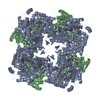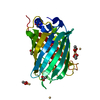+ Open data
Open data
- Basic information
Basic information
| Entry | Database: EMDB / ID: EMD-9104 | |||||||||
|---|---|---|---|---|---|---|---|---|---|---|
| Title | Cryo-EM structure of the Ceru+32/GFP-17 protomer | |||||||||
 Map data Map data | The structure of a highly symmetrical, well-defined 16-mer formed by 8 Ceru+32 and 8 GFP-17 | |||||||||
 Sample Sample |
| |||||||||
 Keywords Keywords | Supercharged protein assembly / electrostatic interactions / 16-mer / D4 symmetry / LUMINESCENT PROTEIN | |||||||||
| Function / homology | Green fluorescent protein, GFP / Green fluorescent protein-related / Green fluorescent protein / Green fluorescent protein / bioluminescence / generation of precursor metabolites and energy / Green fluorescent protein Function and homology information Function and homology information | |||||||||
| Biological species |  | |||||||||
| Method | single particle reconstruction / cryo EM / Resolution: 3.47 Å | |||||||||
 Authors Authors | Simon AJ / Zhou Y | |||||||||
| Funding support |  United States, 1 items United States, 1 items
| |||||||||
 Citation Citation |  Journal: Nat Chem / Year: 2019 Journal: Nat Chem / Year: 2019Title: Supercharging enables organized assembly of synthetic biomolecules. Authors: Anna J Simon / Yi Zhou / Vyas Ramasubramani / Jens Glaser / Arti Pothukuchy / Jimmy Gollihar / Jillian C Gerberich / Janelle C Leggere / Barrett R Morrow / Cheulhee Jung / Sharon C Glotzer / ...Authors: Anna J Simon / Yi Zhou / Vyas Ramasubramani / Jens Glaser / Arti Pothukuchy / Jimmy Gollihar / Jillian C Gerberich / Janelle C Leggere / Barrett R Morrow / Cheulhee Jung / Sharon C Glotzer / David W Taylor / Andrew D Ellington /   Abstract: Symmetrical protein oligomers are ubiquitous in biological systems and perform key structural and regulatory functions. However, there are few methods for constructing such oligomers. Here we have ...Symmetrical protein oligomers are ubiquitous in biological systems and perform key structural and regulatory functions. However, there are few methods for constructing such oligomers. Here we have engineered completely synthetic, symmetrical oligomers by combining pairs of oppositely supercharged variants of a normally monomeric model protein through a strategy we term 'supercharged protein assembly' (SuPrA). We show that supercharged variants of green fluorescent protein can assemble into a variety of architectures including a well-defined symmetrical 16-mer structure that we solved using cryo-electron microscopy at 3.47 Å resolution. The 16-mer is composed of two stacked rings of octamers, in which the octamers contain supercharged proteins of alternating charges, and interactions within and between the rings are mediated by a variety of specific electrostatic contacts. The ready assembly of this structure suggests that combining oppositely supercharged pairs of protein variants may provide broad opportunities for generating novel architectures via otherwise unprogrammed interactions. | |||||||||
| History |
|
- Structure visualization
Structure visualization
| Movie |
 Movie viewer Movie viewer |
|---|---|
| Structure viewer | EM map:  SurfView SurfView Molmil Molmil Jmol/JSmol Jmol/JSmol |
| Supplemental images |
- Downloads & links
Downloads & links
-EMDB archive
| Map data |  emd_9104.map.gz emd_9104.map.gz | 40.1 MB |  EMDB map data format EMDB map data format | |
|---|---|---|---|---|
| Header (meta data) |  emd-9104-v30.xml emd-9104-v30.xml emd-9104.xml emd-9104.xml | 13.4 KB 13.4 KB | Display Display |  EMDB header EMDB header |
| FSC (resolution estimation) |  emd_9104_fsc.xml emd_9104_fsc.xml | 7.8 KB | Display |  FSC data file FSC data file |
| Images |  emd_9104.png emd_9104.png | 223.5 KB | ||
| Filedesc metadata |  emd-9104.cif.gz emd-9104.cif.gz | 6 KB | ||
| Archive directory |  http://ftp.pdbj.org/pub/emdb/structures/EMD-9104 http://ftp.pdbj.org/pub/emdb/structures/EMD-9104 ftp://ftp.pdbj.org/pub/emdb/structures/EMD-9104 ftp://ftp.pdbj.org/pub/emdb/structures/EMD-9104 | HTTPS FTP |
-Validation report
| Summary document |  emd_9104_validation.pdf.gz emd_9104_validation.pdf.gz | 606.1 KB | Display |  EMDB validaton report EMDB validaton report |
|---|---|---|---|---|
| Full document |  emd_9104_full_validation.pdf.gz emd_9104_full_validation.pdf.gz | 605.7 KB | Display | |
| Data in XML |  emd_9104_validation.xml.gz emd_9104_validation.xml.gz | 10 KB | Display | |
| Data in CIF |  emd_9104_validation.cif.gz emd_9104_validation.cif.gz | 13 KB | Display | |
| Arichive directory |  https://ftp.pdbj.org/pub/emdb/validation_reports/EMD-9104 https://ftp.pdbj.org/pub/emdb/validation_reports/EMD-9104 ftp://ftp.pdbj.org/pub/emdb/validation_reports/EMD-9104 ftp://ftp.pdbj.org/pub/emdb/validation_reports/EMD-9104 | HTTPS FTP |
-Related structure data
| Related structure data |  6mdrMC M: atomic model generated by this map C: citing same article ( |
|---|---|
| Similar structure data |
- Links
Links
| EMDB pages |  EMDB (EBI/PDBe) / EMDB (EBI/PDBe) /  EMDataResource EMDataResource |
|---|---|
| Related items in Molecule of the Month |
- Map
Map
| File |  Download / File: emd_9104.map.gz / Format: CCP4 / Size: 42.9 MB / Type: IMAGE STORED AS FLOATING POINT NUMBER (4 BYTES) Download / File: emd_9104.map.gz / Format: CCP4 / Size: 42.9 MB / Type: IMAGE STORED AS FLOATING POINT NUMBER (4 BYTES) | ||||||||||||||||||||||||||||||||||||||||||||||||||||||||||||
|---|---|---|---|---|---|---|---|---|---|---|---|---|---|---|---|---|---|---|---|---|---|---|---|---|---|---|---|---|---|---|---|---|---|---|---|---|---|---|---|---|---|---|---|---|---|---|---|---|---|---|---|---|---|---|---|---|---|---|---|---|---|
| Annotation | The structure of a highly symmetrical, well-defined 16-mer formed by 8 Ceru+32 and 8 GFP-17 | ||||||||||||||||||||||||||||||||||||||||||||||||||||||||||||
| Projections & slices | Image control
Images are generated by Spider. | ||||||||||||||||||||||||||||||||||||||||||||||||||||||||||||
| Voxel size | X=Y=Z: 1.1 Å | ||||||||||||||||||||||||||||||||||||||||||||||||||||||||||||
| Density |
| ||||||||||||||||||||||||||||||||||||||||||||||||||||||||||||
| Symmetry | Space group: 1 | ||||||||||||||||||||||||||||||||||||||||||||||||||||||||||||
| Details | EMDB XML:
CCP4 map header:
| ||||||||||||||||||||||||||||||||||||||||||||||||||||||||||||
-Supplemental data
- Sample components
Sample components
-Entire : Ceru+32/GFP-17 protomer
| Entire | Name: Ceru+32/GFP-17 protomer |
|---|---|
| Components |
|
-Supramolecule #1: Ceru+32/GFP-17 protomer
| Supramolecule | Name: Ceru+32/GFP-17 protomer / type: complex / ID: 1 / Parent: 0 / Macromolecule list: all |
|---|---|
| Source (natural) | Organism:  |
| Molecular weight | Theoretical: 430 KDa |
-Macromolecule #1: Ceru+32
| Macromolecule | Name: Ceru+32 / type: protein_or_peptide / ID: 1 Details: Mutations present in the construct but not listed in the mutation list are derived from the reference construct (PDB entry 2B3P). Number of copies: 8 / Enantiomer: LEVO |
|---|---|
| Source (natural) | Organism:  |
| Molecular weight | Theoretical: 28.425195 KDa |
| Recombinant expression | Organism:  |
| Sequence | String: MASKGERLFR GKVPILVELK GDVNGHKFSV RGKGKGDATN GKLTLKFICT TGKLPVPWPT LVTTLTWGVQ CFARYPKHMK RHDFFKSAM PKGYVQERTI SFKKDGTYKT RAEVKFEGRT LVNRIKLKGR DFKEKGNILG HKLRYNGISD KVYITADKRK N GIKAKFKI ...String: MASKGERLFR GKVPILVELK GDVNGHKFSV RGKGKGDATN GKLTLKFICT TGKLPVPWPT LVTTLTWGVQ CFARYPKHMK RHDFFKSAM PKGYVQERTI SFKKDGTYKT RAEVKFEGRT LVNRIKLKGR DFKEKGNILG HKLRYNGISD KVYITADKRK N GIKAKFKI RHNVKDGSVQ LADHYQQNTP IGRGPVLLPR NHYLSTRSVL SKDPKEKRDH MVLLEFVTAA GIKHGRDERY KL EHHHHHH UniProtKB: Green fluorescent protein |
-Macromolecule #2: GFP-17
| Macromolecule | Name: GFP-17 / type: protein_or_peptide / ID: 2 Details: Mutations present in the construct but not listed in the mutation list are derived from the reference construct (PDB entry 2B3P). Number of copies: 8 / Enantiomer: LEVO |
|---|---|
| Source (natural) | Organism:  |
| Molecular weight | Theoretical: 27.226242 KDa |
| Recombinant expression | Organism:  |
| Sequence | String: MSKGEELFTG VVPILVELDG DVNGHKFSVR GEGEGDADNG KLDLKFICTT GKLPVPWPTL VTTLTYGVQC FSRYPDHMKE HDFFKSAMP EGYVQERTIS FKDDGTYKTR AEVKFEGDTL VNRIELKGID FKEDGNILGH KLEYNFNSHE VYITADDEKN G IKAEFKIR ...String: MSKGEELFTG VVPILVELDG DVNGHKFSVR GEGEGDADNG KLDLKFICTT GKLPVPWPTL VTTLTYGVQC FSRYPDHMKE HDFFKSAMP EGYVQERTIS FKDDGTYKTR AEVKFEGDTL VNRIELKGID FKEDGNILGH KLEYNFNSHE VYITADDEKN G IKAEFKIR HNVEDGSVQL ADHYQQNTPI GDGPDLLPDE HYLSTQSVLS KDPNEKRDHM VLLEFVTADG ITEGHHHHHH HH UniProtKB: Green fluorescent protein |
-Experimental details
-Structure determination
| Method | cryo EM |
|---|---|
 Processing Processing | single particle reconstruction |
| Aggregation state | particle |
- Sample preparation
Sample preparation
| Buffer | pH: 7.4 |
|---|---|
| Grid | Model: C-flat-1.2/1.3 4C / Material: COPPER / Support film - Material: CARBON / Support film - topology: HOLEY / Pretreatment - Type: PLASMA CLEANING / Pretreatment - Time: 30 sec. |
| Vitrification | Cryogen name: ETHANE / Chamber humidity: 100 % / Instrument: FEI VITROBOT MARK IV |
- Electron microscopy
Electron microscopy
| Microscope | FEI TITAN KRIOS |
|---|---|
| Image recording | Film or detector model: GATAN K2 SUMMIT (4k x 4k) / Detector mode: COUNTING / Average exposure time: 6.0 sec. / Average electron dose: 40.0 e/Å2 |
| Electron beam | Acceleration voltage: 300 kV / Electron source:  FIELD EMISSION GUN FIELD EMISSION GUN |
| Electron optics | C2 aperture diameter: 100.0 µm / Illumination mode: FLOOD BEAM / Imaging mode: BRIGHT FIELD / Nominal defocus max: 3.0 µm / Nominal defocus min: 1.5 µm / Nominal magnification: 22500 |
| Sample stage | Specimen holder model: FEI TITAN KRIOS AUTOGRID HOLDER / Cooling holder cryogen: NITROGEN |
| Experimental equipment |  Model: Titan Krios / Image courtesy: FEI Company |
 Movie
Movie Controller
Controller











 Z (Sec.)
Z (Sec.) Y (Row.)
Y (Row.) X (Col.)
X (Col.)























